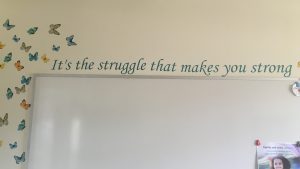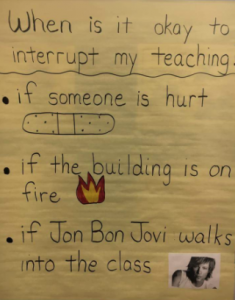Setting Up Your Classroom for Success
As the beginning of the school year is fast approaching, setting up your classroom for success is more than theming your classroom and furniture placement. It is also ensuring you are clear on your philosophies, processes and outcomes.
Here are a few ideas to consider…
Safety First
Not all classrooms are created equal and particularly from the safety aspect. Making your classroom a physically welcome place to be is just a start. For students to grow, progress and thrive, they must be willing to make mistakes, take risks and give new ideas a go – without fear of ridicule, punishment or judgement. My observation in thousands of classrooms throughout the world is of students fearful of making mistakes and dumbing down their efforts to make life easy or avoid being wrong. A simple example of this is when students are unable to spell a word correctly, so instead use a simpler word as a substitute.
Start the year with discussions about the many ways the brain learns and the importance of making mistakes.  Use learning analogies such as learning to walk or riding a bike. I’m particularly fond of the Monarch Butterfly analogy, as they are plentiful at the start of the year. Explain to the students if you help the butterfly out of the chrysalis, it will die. It is the struggle that makes it strong. Talk about how it is a teacher’s job is to give challenging work to help students’ brains and learning muscles be strong.
Use learning analogies such as learning to walk or riding a bike. I’m particularly fond of the Monarch Butterfly analogy, as they are plentiful at the start of the year. Explain to the students if you help the butterfly out of the chrysalis, it will die. It is the struggle that makes it strong. Talk about how it is a teacher’s job is to give challenging work to help students’ brains and learning muscles be strong.
When students understand the learning process (see my blogs; How do students know they know?, Everything is hard before is is easy, MLE’s – the underlying philosophies) and have the language to explain it, it is often easier to create a culture where mistakes are acceptable. However, if students feel unsafe and are unsure how others will react, namely teachers, peers and parents, then they are often less likely to take a risk, stretch, grow and learn.
One idea might be to simply relabel mistakes to ‘learning experiences.’ This may sound a simple matter of semantics, however when you see what happens within the brain between being told you have “made a mistake” and had a “learning experience” – the effect is very different.
Another idea might be to focus on the learning opportunities, rather than the results. For example, instead of writing 7/10 on a students work, and by all means celebrate this success, focus on the learning opportunity – 3 more to learn.
Encourage Student Centred Learning
In a world where access to information is almost instant and available 24/7, the teacher is no longer the fountain of all knowledge or the sage on the stage. The role of the teacher is changing. Arthur C Clarke once said, “If a teacher can be replaced by a machine, they should be.” To be irreplaceable, working toward more student lead learning is critical. This means not all learning is required to go through the teacher. For example, while conducting discussions, instead of all the dialogue coming through you, invite students to participate in a Think – Pair – Share. Firstly, give them time to think about their responses, secondly pair them up so they can converse and chat about their ideas with a partner and lastly, invite students to share their or their partner’s ideas. The safer your classroom environment is the more thoughtful and meaningful the discussion is likely to be.
To encourage a self directed approach, explicitly teach students what to do when they are stuck or don’t know what to do. If they are always coming to you for help, your classroom is still teacher centred. Chat to your students about the options they have for when they are stuck – create a poster or chart as a reminder. Here are two of my favourites…

Classroom display

A fun poster for when you are working with a small group
Teach students how to persist, think flexibly, take a responsible risk, strive for accuracy etc.
Create Strong Rituals:
You may have heard the phrase, “Don’t smile ‘til Easter” and it relates to taking time at the beginning of the year to instil routines and rituals, which will sustain learning for the rest of the year. Once your routines are set, you should be able to step back and let the students, as Nike says, ‘just do it.’ If in the latter terms of the school year, you are still instructing students how to ‘do’ a routine task, you have either not embedded the routine enough, or you have not ‘let go’ of needing to be in control. There are 6 steps to ensuring your routines and rituals in the classroom are student centred.
1. Decide. Start by deciding on which routines will be important in your classroom. Here are a few ideas…
- Greeting – how might you positively and personally greet each student every day.
- Opening – in what ways could you start you class each day/lesson. My daughters class light a candle each morning and conduct a morning circle to create a calm and peaceful atmosphere. My class sang 2 songs and did a fitness routine. Others might start with a thinking puzzle, a review of the last lesson or a hook to generate interest in the lesson content.
- What to do when you have completed the task
- Late arrivals
- Entering and exiting the classroom
- Going to the toilet
- Signalling for quiet
- End of the class – how might you reinforce the learning at the end of a class or topic? Ideas include; sharing circle, one thing I have learned today, a question you still have from today, gratitude, sing a song…
2. Teach. Explicitly teach students how to successfully do the tasks and routines. It is not enough to assume they know how. I once saw a teacher invite students to role play how to deal with another student who was bothering them while they were working. She had two students come to the front of the classroom with their desks, and one works while the other was annoying. The class then brainstormed what appropriate actions could be taken. Students were then split into groups and role played the techniques and ideas. Similarly, my own class was not required to line up to walk to another part of the school. Instead we discussed what it would look and sound like to move from point A to B, respectfully. We then did steps 3-6.3. Practice. At this stage you simply practice the skill or routine over and over again.
4. Feedback. Give specific feedback to assist students to refine the routine.
5. Practice again. This step is often missed and teachers either give up and introduce a different routine, or continue with the substandard routine. Repeat steps 4 & 5 with a sprinkling of 6 until your students can independently complete the routine successfully.
6. Celebrate. Let students know they have been successful in learning the routine and celebrate their efforts. Now for the hardest step for many teachers, leave them to it. Be the guide on the side and facilitate learning, rather than be at the centre of it.
Another key to success is to only establish a few routines at a time. The effort at the beginning of the year is worth it, as it frees you up to be able to focus on the big picture and the learning for the rest of the year.
How would you like your students to be?
As you start the year and get to know your students, take some time to reflect on how you would like them to be, because of your teaching and learning. By the end of the year, how would you like them to think about themselves, their attitudes towards learning, act in challenging situations, the quality of their work, the nature of their discussions, their team work etc. Get clear on the outcomes you have for your students, with both class wide and individual goals. Remember you have forty weeks, so choose what you believe will help them most in their learning journey and will assist them in their next steps of that journey.
Henry Adams is quoted to have said, “A teacher affects eternity. You can never tell where your influence stops.”

It is such a privilege to be the coach and facilitator of learning and shaping young minds every year. Enjoy the challenge and the honour as you have a successful year.
Tags: making mistakes, outcomes, routines, setting up classroom
Published on Friday, January 13th, 2017, under Learning, Modern learning environment, Teacher Effectiveness

Thanks for the inspiration and guidance as we get set for the new teaching year. Love the common sense, gentle starting you suggest focusing on taking time to learn about learning and our beautiful brains as well as how we work together and getting to know each other as learners. Always on point!
I was reflecting on the 40 weeks – not really that long and the need to be clear on the outcomes…
Thanks Karen… getting ready for a new year.. really great info to share with my/our staff!
J
Thanks Judy – much more to come…
Thanks Karen. What an impressive blog and very kind of you to share. Best wishes for a happy year.
Thanks Paula 🙂
A guide on the side resonates well with me. I’m following this advice wholeheartedly .
Hi Karen, thanks for this article. I spent a lot of time last year teaching my class about growth mindset and seeing mistakes as learning opportunities, with great success. After reading this article I realised I still ask my childen to edit their work by saying “Check for mistakes” … woops! Any suggestions for rephrasing this? Thanks
Hi Cheryl – you might like to use “What’s next?” as a prompt – I find so often students come to the teacher for affirmation of each step – they actually know what they need to do and look for positive reinforcement of each stage – I endevour not to give this by focusing on the procedure rather than the work they have done. In the long term – when they have a job, no-one is going to tell them they have done a great job after every task – it is about developing the sense of internal worthiness.
Rainbows and sunshine
Karen
Hi Karen,
I love the idea of 3 more to learn rather than 7/10. I will definitely rephrase in this way. Last year, as a whole staff, Growth Mindset was a big focus, especially around mistakes and seeing them as learning opportunities or learning experiences. Thanks so much for your informative articles and the simple and practical ideas we can use in our classrooms and across the school.
Cheers
Hi Karen
I think this is a great reminder for teachers at the start of the year and I will share it with the staff, for them to read and take on board also. Thanks for sharing it.